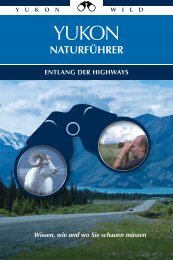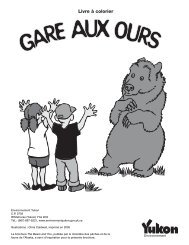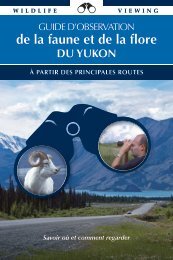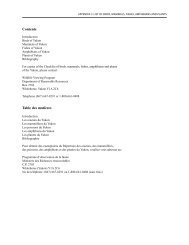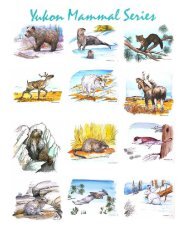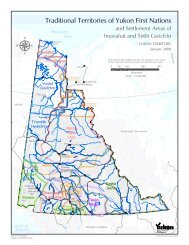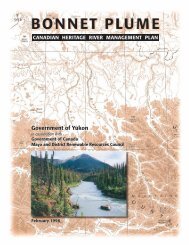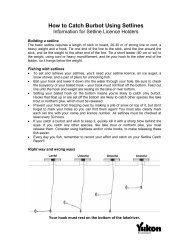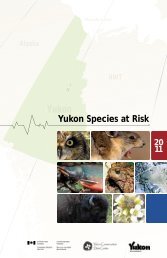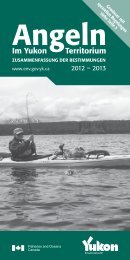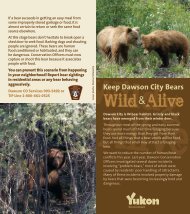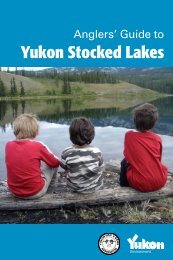Ch. 3 Land - Environment Yukon
Ch. 3 Land - Environment Yukon
Ch. 3 Land - Environment Yukon
Create successful ePaper yourself
Turn your PDF publications into a flip-book with our unique Google optimized e-Paper software.
the Canadian Wildlife Service), or<br />
through four <strong>Yukon</strong> government agencies<br />
(Parks and Outdoor Recreation,<br />
Wildlife, Heritage, and <strong>Environment</strong>al<br />
Protection branches).<br />
The guiding principles for establishing<br />
the protected areas network begin with<br />
ecological integrity. Through a process<br />
of public participation, partnerships,<br />
accountability, quality of information<br />
and coordination, the network will<br />
respect all values, recognizing economic<br />
interests and contributing to<br />
sustainable development.<br />
Process to Establish<br />
Protected Areas<br />
1. The Protected Areas Secretariat<br />
identifies the first ecoregions<br />
and areas of interest.<br />
2. Local planning team is<br />
established in the First Nation<br />
Traditional Territory to work<br />
with community stakeholders,<br />
and the <strong>Yukon</strong> public.<br />
3. Local planning team identifies<br />
the study area.<br />
4. Government reviews and<br />
approves the study area.<br />
5. Local planning team completes<br />
the proposal for the protected<br />
area.<br />
6. Review by the Development<br />
Assessment Process.<br />
7. Final government (cabinet)<br />
review and approval<br />
8. Designation of the protected<br />
area.<br />
9. Preparation of a management<br />
plan and submission to<br />
government for approval.<br />
10. Periodic review and update of<br />
the management plan every five<br />
years.<br />
Protected areas in the <strong>Yukon</strong> range<br />
from relatively small ecological areas to<br />
extensive wilderness preserves. Some<br />
reserves in the <strong>Yukon</strong> have strict<br />
provisions for preservation of the<br />
complete ecosystem; others include<br />
only provisions to limit wildlife<br />
harvesting.<br />
<strong>Yukon</strong> protected areas and sanctuaries<br />
are shown in Figure 3.5 and the<br />
ecoregions of the <strong>Yukon</strong> are shown in<br />
Figure 3.4.<br />
Some ecoregions are well represented<br />
in the protected areas network (Figure<br />
3.6). The priority regions for the<br />
establishment of protected areas are<br />
the British–Richardson Mountains,<br />
Eagle Plains, Peel River Plateau and<br />
Fort MacPherson in the north and the<br />
Southern Lakes and Pelly Mountains.<br />
A network of protected areas will<br />
maintain bio-diversity, protect wildlife<br />
and watersheds, preserve unique,<br />
natural, scenic, historic and cultural<br />
areas, preserve the genetic diversity of<br />
species, and preserve wilderness.<br />
Cooperation between different sectors<br />
of government and industry is<br />
important to the establishment of<br />
protected areas which meet the<br />
objectives of the strategy. One issue<br />
which has been raised relates to mining.<br />
Though in many cases mining claims<br />
have lapsed in proposed park areas,<br />
some staking on or adjacent to<br />
proposed protected areas has occurred.<br />
<strong>Ch</strong>apter 10 of the Tr’ondëk Hwëch’in<br />
Final Agreement outlines the process<br />
for establishing the Tombstone Territorial<br />
Park, and a study area was established<br />
in April of 1997. A steering<br />
committee was struck in 1999 to<br />
recommend a final park boundary.<br />
There were 380 valid mineral claims<br />
Figure 3.6 Representation of Ecoregions in the Protected Area Network<br />
4 0 ❧ Y U K O N S T A T E O F T H E E N V I R O N M E N T R E P O R T 1999





